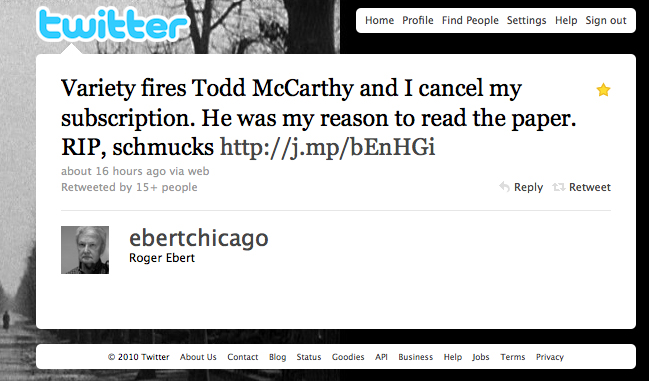Starting today, the editor’s blog will feature an afternoon roundup of all things media from over the pond. From the hugely important to the very inconsequential, check in for a choice of America’s journalistic goings on.
paidContent 2010
The issue of paid content was high on the agenda at the end of last week with the paidContent 2010 conference in New York. In attendance were big names from the New York Times: Arthur Sulzberger, Jr., chairman and publisher; Janet Robinson, president and CEO; and Martin Nisenholtz, senior vice president of digital operations, who were interviewed at length by ContentNext’s Staci D. Kramer on “metered news and more”.
According to the paidContent coverage, “while they were willing to buy lunch, they weren’t ready to feed the appetite for detail about plans for NYTimes.com to go metered in 2011”.
See the video here
And the full conference coverage from the paidContent site here
“Does the bleeding ever stop at 425 Portland?”

image courtesy of Stephen Cummings
Presumably, ways of making newspaper journalism pay were also high on the agenda over in Minneapolis at the end of last week, where the Star Tribune announced that five voluntary redundancies would be offered to reporters and editors. “Does the bleeding ever stop at 425 Portland?” asks MinnPost.
Staff memo here
Pessimistic stories of this kind, including this one, continue to be thoughtfully aggregated by blogger and pessimist extraorinaire Fading To Black. Not featured on this chronicle of US newspaper decline was the story that down in South Florida, rather than asking him if he’d like to pack his things, the Sun Sentinel handed production maintenance manager Bob Simons a $25,000 spot bonus and a Caribbean holiday. Simons’ suggestion of a different supplier for equipment apparently saved the paper $1 million.
A very different staff memo here
AP underperforms on non-profit content distribution
An interesting story from the Nieman Jounalism Lab reports on the outcome of Associated Press’ decision to distribute content from America’s top four non-profit news outlets: ProPublica, Centre for Public Integrity, Centre for Investigative Reporting, and the Investigative Reporting Workshop.
The six-month project was launched back in June 2009 at the Investigative Reporters and Editors conference in Baltimore, “with great fanfare” according to Bill Buzenberg, executive director of Centre for Public Integrity.
It seems however that the scheme hasn’t been successful so far, with admissions from both the AP and the non-profit directors that very little content has made it into print. A poor distribution model is to blame apparently, with new non-profit content not being sufficiently flagged.
“They haven’t done the technical backup work to really make it work,” said Buzenburg. “They haven’t made it a priority.”
However, hope remains for the project from both sides. Buzenburg added: “This is a good idea. I’d like it to work […] The potential of this remains.”
“It’s early yet – we’re only six months into it,” said John Raess, AP’s San Francisco bureau chief.
“We want our celebrities to show a little leg”

image courtesy of Jim Epler
Much of the weekend’s media coverage in the US was given over to Tiger Wood’s much-publicised public apology on Friday morning. Mediabistro nailed the best format for coverage by inviting readers to pen Haikus for the Mediabistro facebook page. Submissions include this clear frontrunner from Pamela Ross:
“Questions? Don’t go there.
My Thanksgiving meal was ruined.
Thanks. Now. Watch this swing.”
With more syllables at his disposal, David Carr of The New York Times’ Media & Advertising pages goes into a little more detail, considering the relationship between celebrity sportsmen and the media:
Athletes and actors would like for us to focus on the work, while reporters know that their editors and audience want more, because while the work is visible, we want our celebrities to show a little leg.
But once this bit of leg, so strictly concealed by Woods for so long, has been shown, why are the media who feed on it so relentlessly owed some sort of apology?
Those of us who have had some experience with human frailties all know why Tiger Woods did what he did last Friday, which was to get in a room with people he had hurt or embarrassed to say he was “deeply sorry” for what he had done. That part made sense, the beginning of a process of amends.
I just don’t know what the rest of us were doing there.
A sentiment echoed this side of the pond by Charlie Brooker today in the Guardian.
There are those that must hope that, now this enigmatic character has addressed his hushed audience, and delivered his much anticpated talk, that the hype, rumour, pontificating, and endless media coverage will die away.
Apple wields knife over TV show prices
It is fair to say that at least a few people thought exactly the same thing about Steve Jobs’ unveiling of the iPad. But the so-called saviour of the newspapers is back in the media spotlight this week with news that Apple are considering halving the current price of television shows on iTunes from $1.99 to 0.99 cents. Media commentators have hailed the iTunes store’s 125 million registered customers as a potential liferaft for sinking newspaper publishers, and major networks may be wary of waving a pin anywhere near that customer base by rejecting the move, instead gambling on even a small percentage increase in those paying for TV offsetting the significant price drop.

image courtesy of curiouslee
Meanwhile, Adobe and Conde Nast have jumped right aboard the good ship iPad, unveiling “a new digital magazine experience based on WIRED magazine” at the TED Conference in Long Beach, California.
The Church of Scientology vs. the St. Petersburg Times, Round 1
And finally, from Howard Kurtz’s Media Notes at the Washington Post, the improbable story that the Church of Scientology, in a tit-for-tat response to investigations by the St. Petersburg Times of Tampa Bay, has organised some investigative journalism of its own.

image courtesy of Ben Sutherland
The church has officially hired three ‘veteran reporters’ – a Pulitzer Prize winner, a former “60 Minutes” producer, and the former executive director of Investigative Reporters and Editors – to look in detail at the newspapers’ conduct. Steve Weinberg, the former IRE executive, who was paid $5,000 to edit the study, says that the agreement stipulates the church publish the study in full or not at all.
Weinberg claims that in spite the study being bankrolled by the church, it will be objective. Neil Brown, executive editor of the St. Petersburg Times, thinks otherwise:
“I ultimately couldn’t take this request very seriously because it’s a study bought and paid for by the Church of Scientology.”
Brown seems to feel a bit hard done by in this instance:
“I counted up something like six or seven journalists the church has hired to look into the St. Petersburg Times. I’ve just got two looking into the Church of Scientology,” he complained.
No fair.





